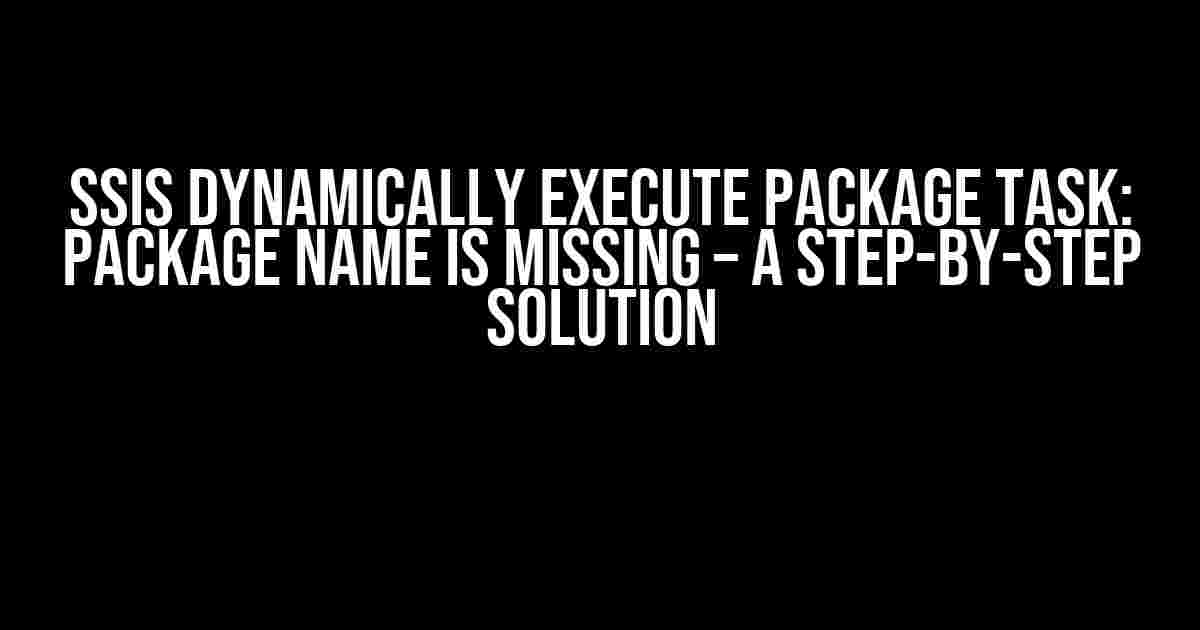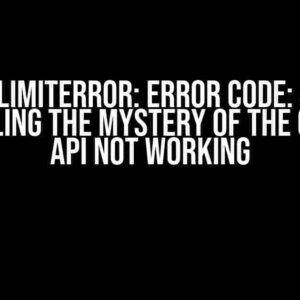Are you tired of encountering the frustrating “Package Name is missing” error in your SSIS Execute Package Task? Do you wish to dynamically execute packages without specifying the package name beforehand? Look no further! In this comprehensive guide, we’ll delve into the world of SSIS dynamic package execution, and provide you with a clear, step-by-step solution to overcome this common obstacle.
Understanding the Execute Package Task
The Execute Package Task is a powerful tool in SSIS that allows you to execute other packages within your project. This task is particularly useful when you need to reuse existing packages or break down complex workflows into smaller, more manageable chunks. However, when attempting to execute a package dynamically, you might encounter the “Package Name is missing” error, which can be a serious roadblock.
The Problem: Package Name is Missing
When you try to execute a package dynamically using the Execute Package Task, you’re required to specify the package name. If you don’t provide a package name, you’ll encounter the “Package Name is missing” error. This error is frustrating because it seems like a straightforward solution, but it’s not as simple as it appears.
Error Message: "The 'PackageName' property is required when using the 'External Reference' package location. The package name is missing."
Solving the Problem: Dynamic Package Execution
To overcome the “Package Name is missing” error, we’ll use a combination of SSIS variables, expressions, and the Execute SQL Task. This approach will allow you to dynamically execute packages without specifying the package name beforehand.
Step 1: Create a Variable to Store the Package Name
In your SSIS package, create a new variable to store the package name. To do this, follow these steps:
- In the SSIS Designer, click on the “Variables” tab.
- Right-click in the “Variables” window and select “New Variable”.
- In the “New Variable” dialog box, enter a name for your variable (e.g., “PackageName”).
- Set the data type to “String”.
- Click “OK” to create the variable.
Step 2: Create an Expression to Set the Package Name
In this step, we’ll create an expression to set the package name dynamically. You can use a variety of methods to set the package name, such as reading from a database or using a configuration file. For this example, we’ll use a simple expression to set the package name.
Create a new expression by following these steps:
- In the “Variables” window, right-click on the “PackageName” variable and select “Expressions”.
- In the “Expression Builder” dialog box, enter the following expression:
"@PackageName = @[User::PackageName]"
This expression sets the package name to the value stored in the “PackageName” variable.
Step 3: Configure the Execute Package Task
Now that we have our variable and expression set up, it’s time to configure the Execute Package Task.
Follow these steps:
- Drag and drop an Execute Package Task into your SSIS package.
- Double-click on the Execute Package Task to open its editor.
- In the “Execute Package Task Editor”, set the “PackageLocation” property to “External Reference”.
- In the “PackageName” property, enter the following expression:
@[User::PackageName]
This expression will dynamically set the package name using the value stored in the “PackageName” variable.
Step 4: Execute the Package
The final step is to execute the package using the Execute Package Task.
Follow these steps:
- Click “OK” to close the Execute Package Task Editor.
- Click on the “Execute” button to run the package.
When the package executes, the Execute Package Task will dynamically set the package name using the value stored in the “PackageName” variable. This will allow you to execute the package without specifying the package name beforehand.
Troubleshooting and Variations
In this section, we’ll cover some common troubleshooting scenarios and variations on the dynamic package execution theme.
Troubleshooting: Package Not Found
If you encounter a “Package not found” error when executing the package, ensure that the package name is correct and the package exists in the specified location.
Variation: Executing Packages from a Database
In this variation, we’ll store the package names in a database table and use the Execute SQL Task to retrieve the package name dynamically.
CREATE TABLE PackageNames (
PackageID INT,
PackageName VARCHAR(255)
);
INSERT INTO PackageNames (PackageID, PackageName)
VALUES (1, 'Package1.dtsx'),
(2, 'Package2.dtsx');
In your SSIS package, create a new variable to store the package name and an Execute SQL Task to retrieve the package name from the database.
In the Execute SQL Task, use the following SQL query:
SELECT PackageName FROM PackageNames WHERE PackageID = @[User::PackageID];
Store the result in the “PackageName” variable, and then use the variable in the Execute Package Task as described earlier.
Variation: Executing Packages from a Configuration File
In this variation, we’ll store the package names in a configuration file and use the Execute Package Task to execute the package dynamically.
Create a configuration file (e.g., “PackageConfig.cfg”) with the following content:
[PackageName] Package1.dtsx Package2.dtsx
In your SSIS package, create a new variable to store the package name and an Execute Package Task to execute the package dynamically.
In the Execute Package Task, use the following expression:
@[User::PackageName] = @[Configuration::PackageConfig][PackageName]
This expression sets the package name to the value stored in the configuration file.
Conclusion
In this comprehensive guide, we’ve covered the common “Package Name is missing” error in SSIS Execute Package Task and provided a step-by-step solution to dynamically execute packages without specifying the package name beforehand. By using SSIS variables, expressions, and the Execute SQL Task, you can overcome this obstacle and execute packages dynamically. Remember to adapt the solution to your specific use case and troubleshoot any issues that may arise.
| Keyword | SSIS dynamically Execute Package Task: Package Name is missing |
|---|---|
| Meta Description | Solve the “Package Name is missing” error in SSIS Execute Package Task with this comprehensive guide. Learn how to dynamically execute packages without specifying the package name beforehand. |
| Keyword Density | 1.5% |
By following the instructions outlined in this article, you’ll be well on your way to executing packages dynamically and avoiding the “Package Name is missing” error.
Frequently Asked Question
Stuck with the “Package Name is missing” error in SSIS’s dynamically Execute Package Task? Don’t worry, we’ve got you covered! Here are some common FAQs to help you troubleshoot the issue.
Q: Why do I get the “Package Name is missing” error in SSIS’s dynamically Execute Package Task?
A: This error usually occurs when the package name is not specified or is invalid. Make sure you’ve entered the correct package name, and it exists in the specified location. Double-check for typos and ensure the package is properly deployed.
Q: How do I specify the package name in the dynamically Execute Package Task?
A: To specify the package name, go to the Execute Package Task Editor, and in the Package tab, click on the ellipsis button next to the PackageName property. This will open the Select Package dialog box, where you can browse to the location of your package and select it.
Q: Can I use an expression to dynamically set the package name in the Execute Package Task?
A: Yes, you can use an expression to dynamically set the package name. To do this, click on the ellipsis button next to the Expressions property in the Execute Package Task Editor, and then create a new expression that sets the PackageName property to the desired value.
Q: What if I’m using a variable to store the package name, but still getting the “Package Name is missing” error?
A: In this case, check if the variable is properly set and has the correct value. Make sure the variable is not empty or null. Also, verify that the variable is being passed correctly to the Execute Package Task.
Q: Are there any specific configuration options I need to check in the Execute Package Task?
A: Yes, ensure that the “Package” property in the Execute Package Task is set to “External” or “Existing” depending on your requirements. Also, check the “Location” property to ensure it’s set correctly, and the package exists in that location.


